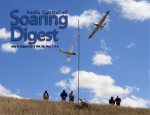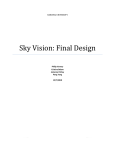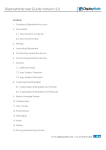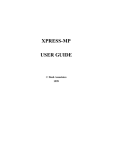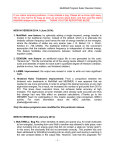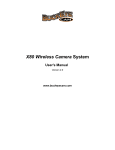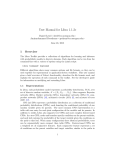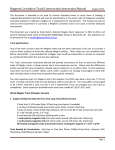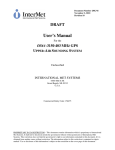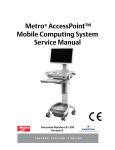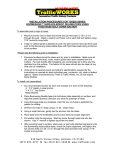Download Sky Vision - Harding University
Transcript
Sky Vision HARDING UNIVERSITY System Design and Project Plan Sky Vision Phil Varney Cristina Belew Julianne Pettey Peng Yang 10/12/2010 1 Sky Vision Table of Contents Background……………………………………………………………………………………………….. 3 System Overview…………………………………………………………………………………………. 4 System Design ……………………………………………………………………………………………. 6 Block Diagram……………………………………………………………………………………. 7 Functional Description of Blocks……………………………………………………………….... 8 Project Plan ……………………………………………………………………………………………...11 Organization and Management…………………………………………………………………...12 Work Breakdown Schedule Fall 2010…………………………………………………………………………………14 Spring 2011………………………………………………………………………………15 Gantt Chart Fall 2010…………………………………………………………………………………17 Spring 2011………………………………………………………………………………18 Network Diagram Fall 2010…………………………………………………………………………………19 Spring 2011………………………………………………………………………………20 Budget…………………………………………………………………………………………….21 Appendices Appendix A: Requirements Specification………………………………………………………..22 Appendix B: FAA Regulations…………………………………………………………………...26 Appendix C: Budget References………………………………………………………………….30 2 Sky Vision Background The goal of Sky Vision is to design and construct a cost effective, mobile flight platform with the capability to remotely capture video and transmit the data to a user on the ground in real time. The need for aerial imaging spans a wide array of markets, such as search and rescue, law enforcement, construction, the media, fire fighting, and general recreation. Aerial imaging greatly expands the capabilities of the aforementioned markets. It reduces the manpower (and thus costs and risks) needed for many dynamic situations, such as monitoring the scene of a crime or surveying the extent of a wildfire. In short, aerial imaging extends the sensing capabilities of a market from a two dimensional field into a third dimension: the sky. Currently, this capability is far too often accomplished through the use of expensive rotary and fixed wing aircraft. The costs of the prior options often far eclipse the resources of many markets, thus necessitating a cost effective alternative. The goal of Sky Vision is therefore to create an aerial imaging product which meets both the high performance and low cost requirements of many under financed markets. Sky Vision will meet the above stated needs by being far less expensive than the current methods used to obtain aerial images. As an alternative to renting or purchasing expensive equipment outright, Sky Vision customers will be able to purchase one of our aerial surveillance systems. Using Sky Vision will be much more convenient for the customer, since the system can be easily transported to the required location. Sky Vision will use a lifting gas such as helium to fly a small video camera to the altitude necessary to obtain the desired live video feed. The camera will transmit the live video feed to a user interface on the ground. The system will be able to be maneuvered and rotated by a lightweight propulsion system. This propulsion system will be remote-controlled from the user interface on the ground. 3 Sky Vision System Overview The goal of Sky Vision is to provide a cost effective method of aerial surveillance for dynamic situations. Sky Vision will consist of a lighter-than-air aerial platform with stable live video imaging and a limited propulsion system. Since most markets with a need for aerial surveillance also demand high adaptability, Sky Vision will measure no more than 1.30 m x 1.04 m x 0.56 m. To satisfy the needs of the customer, Sky Vision will be capable of both 360° of azimuth rotation and 90° of elevation rotation. Azimuth rotation is defined as a horizontal rotation in a fixed reference plane; in this case the fixed reference plane is the plane perpendicular to an axis fixed to the device which passes vertically through the center of gravity of the device when it is in a vertical orientation. Ninety degrees of elevation rotation is defined as a rotation from the previously mentioned fixed plane to a position perpendicular to the plane, directed downward. The propulsion system will provide lateral translation and also rotation to position and orient the azimuth angle of the imaging system. The elevation rotation will be provided independent of the propulsion/orientation system. Sky Vision will be operated by the customer using a portable user interface device. The user interface will provide four important functions: control of the imaging system and viewing of the live video feed, control of the propulsion system (rotation and translation), and control of deflation of the balloon in case of separation from the tethering system (as required FAA regulation 101 subpart B, see Appendix B). To use Sky Vision, the user will remove the system from storage and ensure the aerial platform is correctly secured to the tethering system (prior to inflation with helium gas). The platform will then be connected to the power source and both the platform and user interface will be powered on. The user will then add the required volume of helium gas to inflate the platform (note that the customer will provide any required helium gas, except for that required by system development and testing). The tethering system will then be slowly released, allowing Sky Vision to slowly rise to the desired altitude. Once Sky Vision has reached the desired altitude, the user may then utilize the imaging and propulsion systems to obtain the desired field of view for the live video feed. Once imaging is complete, the user will slowly reel in the device, while 4 Sky Vision visually inspecting the tether for damage. Once the platform has reached ground level, the user will inspect it to ensure the integrity of the platform has not been compromised. The valve system will then be used to remove the helium gas from the platform. Following helium gas removal, the system will be powered off and returned to storage. 5 Sky Vision S y st e m D e s i g n 6 B l o c k D i ag r am Sky Vision 7 Sky Vision F u n c t i o n a l D e s c r i pt i o n o f B l o c k s Propulsion System: The propulsion system will consist of two propulsion units (probably fans) mounted on a rotating shaft. The shaft will be capable of 360° of azimuth rotation. The propulsion units will be capable of providing both stability against wind and lateral translation of balloon. Input: User control signal from user interface via motor control circuit (see ‘User Interface’ functional description for specifics on user input mechanism) Output: Desired rotation (360° in five minutes, or 0.2 rpm) and translation of balloon (maximum of 5 N thrust to stabilize against maximum wind speed) Communication System: The communication system will remotely control the propulsion system of the blimp. It will transmit a signal from the user interface to a motor control circuit that determines the direction and speed of movement. This signal will be transmitted wirelessly and will be in compliance with all relevant FCC communication standards and regulations. Input: Signal generated from remote-control device on user interface and transmitted at radio frequency at 2.4 GHz. Output: Signal to motor control circuit and camera control circuit which sends power to the propulsion units and camera (40 – 100 W to propulsion units and 2 – 6 W to camera system) Power System: The power system provides the necessary power for the propulsion system, user interface, and communication system. The power system consists of a battery, a voltage regulator, and on/off switching system. The power system will provide power to the system for a minimum of one hour, with Input: Power from battery (30 to 100 W). Output: Power to other systems (15 – 40 W to propulsion units and 2 – 6 W to camera system) 8 Sky Vision Tethering System: The tethering system includes both a reel device to allow for ascending and descending of the balloon and also a tethering cable which is capable of supporting the balloon. The device should be deployable to and from its maximum height of 36.6 meters within ten minutes. In order to ensure that the height of the device does not exceed 36.6 meters, the tethering system will only be capable of letting out 36.6 meters of cable. The material will have a factor of safety against rupture of at least 2.0 Inputs: Mechanical reeling force, 1 – 15 N force applied at a sufficient distance. Outputs: Change in device elevation, from zero meters to the maximum height of 36.6 meters. Camera System: The camera system will consist of a small camera mounted onto the balloon. The camera will be capable of 90° elevation rotation, accomplished independent from motion provided by propulsion system. The live video feed will be transmitted to the ground and made viewable on the user interface. The camera will be adjusted to focus at a distance sufficient to accommodate the maximum flight height. The video frame rate will be a constant value (yet to be determined) as predetermined by specific camera selection. Inputs: Control signal from user interface. 9 volt power supply from battery. Outputs: Live video feed displayed on the user interface. Up to 90° elevation rotation. Plat fo rm: The platform consists of both a helium filled balloon and the required mounting infrastructure. The helium filled balloon will provide enough lift to bring the system to the desired elevation, and the required mounting infrastructure will support the imaging and propulsion systems. The platform will also contain a subsystem to rapidly deflate the device in case of tether separation, as dictated by FAA regulation 101 subpart B. Input: Specified volume of helium gas required to lift system (helium gas can lift approximately 1.1 kg/m3 at 20° C and 1 atm. Emergency signal from tether separation sensor. Output: Desired elevation of the system. Rapid deflation of device when emergency tether signal is received; separation of device from tether is a worst case scenario and would result in catastrophic failure of device (most likely outcome: complete destruction of device. 9 Sky Vision User Interfa ce: The user interface consists of the controls necessary to control the propulsion system and imaging system. The user will be able to use the user interface to rotate the system 360° and rotate the camera 90°. The propulsion system controls allow for user control of camera stability. The live video feed will be viewable on the user interface Input: Desired manipulation of propulsion and imaging systems as dictated by user via a system of buttons and/or joysticks in order to accomplish desired imaging. Output: Control signal sent to communication system at 0 to 5 V DC 10 Sky Vision P r o j e c t Pl a n 11 Sky Vision Organization and M anagement Sky Vision’s team consists of two electrical engineering students and two mechanical engineering students. The project tasks will be distributed between the project members as follows: o Philip Varney (Mech. Eng.) - Phil is the project manager of Sky Vision, and primarily responsible for making sure the subsystem plans are completed, integrated, and tested on time. Phil is also responsible for finalizing all required reports and ensuring they are completed on time. Phil will also be responsible for the design and implementation of the propulsion system and the camera rotation system. Phil will work with Cristina to assist her with any difficulties that arise during the development of her responsibilities. o Julianne Pettey (Elec. Eng.) - Julianne is responsible for project financing; specifically, ensuring the budget is under control. The purchasing of any system components will be done through her to ensure the budget outline is followed. Julianne will also be responsible for the design and implementation of the camera system and communication system. She will be responsible for integrating all of the electrical subsystems and ensuring they function properly with the mechanical systems. Julianne will work with Peng to ensure his tasks are done properly and efficiently. o Peng Yeng (Elec. Eng.) - Peng is primarily responsible for designing and implementing the power system. He will also design the user interface system, including controls for both the imaging and propulsion systems. Peng will also work with Julianne to make sure her tasks are completed on schedule and also to assist her in any difficulties which arise during the design and implementation of the camera and communication systems. 12 Sky Vision o Cristina Belew (Mech. Eng.) - Cristina is responsible for the design and implementation of the platform (balloon and mounting frame) and tethering systems. She is also responsible for examining any relevant FAA regulations and dictating to the entire team what is required to ensure FAA regulations are adhered to. Cristina will collaborate with Peng on the mechanical aspect of the user interface design. She will also assist Phil in any difficulties encountered during the design and implementation of the propulsion and camera rotation systems. 13 Sky Vision Work Breakdow n Schedule Fall 2010 ID Activity Description F1.0 F 2.0 Project Management Documentation F 3.0 Project Choice F4.0 Requirements Specification System Design & Project Plan Ensure project is completed correctly and on time Ensure changes and progress is recorded Decide on which problem solution to pursue Complete set of all system requirements Report of semester goals and deadlines, along with functional descriptions of subsystems Complete design of subsystems F 5.0 F6.0 Device Design F6.1 Platform Design Design of balloon and mounting infrastructure F6.2 Camera Design F 6.2.1 Imaging Design Design of imaging system and camera rotation system Design of camera system to provide live video feed F 6.2.2 Camera Rotation Design Design of system to rotate camera 90° F6.3 Propulsion Design Stabilize, rotate, and translate device F6.4 Power Design Design power system to power device F6.5 Communication Design Design system to transmit user inputs/outputs to/from device F6.6 Tether Design Design system to secure device and transmit power F6.7 User Interface Design F7.0 System Design and Analysis Final Design Design system to receive inputs and display live video feed Ensure correct integration of subsystems and order parts The final design of system and subsystems F8.0 · Deliverables/ Checkpoints Description of team member task completion Engineering notebooks, A3 reports, and design reports Problem specification report Requirements specification document System Design and Project Plan final report Component selection and performance specifications. of subsystems Type of balloon; performance specifications of balloon; design of mounting brackets Camera selection; camera rotation design Camera selection and performance specifications; data transmitter and receiver Motor and mounting system selection; performance specifications Propulsion unit design and selection; movement specifications; mounting design; performance specifications Battery selection; power distribution design; performance specifications Communication method selected; control circuitry design; performance specifications Selection of tethering cord; reeling device design; performance specifications User interface control circuitry designed; case/type of controls designed; performance specs. Final system design and documentation of parts ordering Final Design Report (includes schematics and project model) Please note that ‘performance specifications’ includes test results 14 Duration (days) Aug. 23rd – Dec. 9th Aug. 23rd – Dec. 9th Aug. 23rd – Sept. 7th Sept. 7th – Sept 28th Sept. 28th – Oct. 12th People Oct. 12th – Nov. 16th Ph, P, J, C Oct. 12th – Nov. 2nd C (1), Ph (2) Oct. 12th – Oct. 26th Oct. 12th – Oct. 26th J, Ph Oct. 12th – Oct. 26th Ph Oct. 12th Oct. 26th Ph (1), C (2) Nov. 2nd – Nov. 16th P (1), J (2) Oct. 26th – Nov. 9th J (1), P (2) Nov. 2nd – Nov. 16th Oct. 22nd – Nov. 9th C (1), Ph (2), P (1) P (1), J (2) Nov. 9th – Dec. 7th Nov. 9th – Dec. 9th Ph, P, J, C Ph, P, J, C Ph Ph, P, J, C Ph, P, J, C Ph, P, J, C Ph, P, J, C J Sky Vision Work Breakdow n Schedule Spring 2011 ID Activity Description S 1.0 Project Management S 2.0 Documentation S 3.0 Device Build S 3.1 Platform Build Ensure project is completed correctly and on time Ensure changes and progress is recorded Complete builds of subsystems Connect mounting infrastructure to balloon S 3.2 Camera Build Build imaging system and camera rotation system S 3.2.1 S 3.2.2 Imaging Build Build camera system Camera Rotation Build Build of camera rotation system S 3.3 Propulsion Build S 3.4 Power Build Build of propulsion system to stabilize, rotate, and translate device Build power system to power device S 3.5 Communication Build Build system to transmit user inputs/outputs to/from device S 3.6 Tether Build Build system to secure device and transmit power S 3.7 User Interface Build Build system to receive inputs and display live video feed S 4.0 Device Testing S 4.1 Platform Testing Complete testing of each subsystem Test the platform to ensure it can support subsystems S 4.2 Camera Testing S 4.2.1 Imaging Testing Ensure camera can provide live feed and rotate through specified angle Ensure the camera can provide satisfactory video feed Deliverables/ Checkpoints Description of team member task completion Duration (days) Jan. 18th – May 5th People Engineering notebooks, A3 reports, design reports All of subsystems connected as specified by design Mounting brackets for tether, propulsion system, and imaging system attached to balloon Imaging and camera rotation subsystems connected. Camera control circuitry built for both imaging and camera rotation Receiver/transmitting circuitry built and connected to camera Camera mounted to elevation rotation shaft and motor. Motor connected to control circuitry Propulsion units built, assembled, and mounted to platform frame Power distribution system and voltage regulating system built and connected to battery Remote control circuitry built and ready to be mounted to user interface and aerial portion of platform Reeling mechanism built and connected to cable. Cable attachment to balloon mechanism built Device to contain interface control circuitry and display screen built. Display screen circuitry built and connected to user interface Test results of subsystems; modification recommendations Results of balloon lift and stability tests; modification recommendations Results of camera imaging and rotation tests; modification recommendations Results of imaging testing; modification recommendations Jan 18th – May 5th Jan. 18th – Feb. 22nd Jan. 18th – Feb. 8th Ph, P, J, C Ph, P, J, C C (1), Ph (2) Jan. 18th – Feb. 1st J, Ph Jan. 18th – Jan. 25th Jan 25th – Feb. 1st J Jan 18th – Feb. 1st Ph (1), C (2) Feb. 8th – Feb. 22nd P (1), J (2) Feb. 1st – Feb. 15th J (1), P (2) Feb. 8th – Feb. 22nd C (1), Ph (2), P (1) Feb. 1st – Feb. 15th P (1), J (2) Feb. 1st – Mar. 8th Feb. 8th – Feb. 22nd Ph, P, J, C C (1), Ph (2) Feb. 1st – Feb. 15th J, Ph Feb. 1st – Feb. 15th J 15 Ph Ph Sky Vision S 4.2.2 Camera Rotation Testing Propulsion Testing Ensure camera can rotate specified elevation range S 4.4 Power Testing S 4.5 Communication Testing S 4.6 Tether Testing S 4.7 User Interface Testing S 5.0 Project Status Ensure power outputs can provide power for all subsystems Ensure system can communicate to device at max. altitude and receive/transmit user signals Ensure tether can support system and transmit power Ensure user interface can transmit/receive signal from/to communication system Statement of project status S 6.0 S 8.0 System Integration System Testing and Modifications User’s Manual S 9.0 Final Report S 4.3 S 7.0 Ensure propulsion provides for rotation and translation Integrate subsystems to ensure correct functionality Testing of total integrated system and corresponding modifications Instructions to user on how to operate system Presentation of final device and system capabilities Actual range of rotation specified; modification recommendations Actual thrust output and rotation rate of mounting shaft quantified; modification recommendations Actual power output quantified; modification recommendations Feb. 1st – Feb. 15th Ph Feb. 1st – Feb. 15th P (1), C (2) Feb. 22nd – Mar. 8th P (1), J (2) Actual communication range quantified; modification recommendations Feb. 15th – Mar. 1st J (1), P (2) Actual reeling force quantified; modification recommendations Test results, modification recommendations Feb. 22nd – Mar. 8th Feb 15th – Mar. 1st C (1), Ph (2) P (1), J (2) Project status report Feb. 15th – April 5th Mar 1st – Mar. 29th Mar. 22nd – April 12th Ph, P, J, C Ph, P, J, C Ph, P, J, C April 19th – May 3rd April 12th – May 3rd Ph, P, J, C Ph, P, J, C Provides fully integrated prototype to test Complete system prototype User’s manual report Final report document 16 Fall 2010 G a n tt C h a rt Sky Vision 17 Spring 2011 G a n tt C h a rt Sky Vision 18 Network Diagram Fall 2010 Sky Vision 19 Network Diagram Spring 2011 Sky Vision 20 Sky Vision B udg e t Item Propulsion System 2 Fans w/ motor Model DFR6B Mount Third positioning motor Possible Vendor Cost Date Estimated www.ductedfans.com $80.00 Sept. 20th, 2010 www.onlinemetals.com www.ductedfans.com $10.00 $20.00 Oct. 4th, 2010 Camera System Camera Receiver Transmitter Battery for camera www.boostervision.com www.boostervision.com www.boostervision.com Wal-Mart $69.99 Included Included $2.00 Sept. 8th, 2010 Sept. 8th, 2010 Sept. 8th, 2010 Oct. 4th, 2010 Main Power Supply Tether cable Misc. cord, etc Main battery Alternative battery Amazon.com TBA Ebay.com www.maxprod.com $50.00 $25.00 $60.00 $20.00 -$40.00 Oct. 4th, 2010 Oct. 4th, 2010 Oct. 4th, 2010 Oct. 11th, 2010 TBA $25.00 $25.00 Oct. 4th 2010 Oct. 11th, 2010 Tethering System All components Tethering cord http://secure.cartsvr.net Platform Balloon Helium gas www.giantadvertisingballons.com $250.00 www.hicodallas.com $100.00 Sept. 28th, 2010 Oct. 11th, 2010 Communication System RC control system Control circuitry www.hobbypartz.com www.sparkfun.com $44.95 $30.00 Oct. 3rd, 2010 Oct. 11th 2010 www.onlinemetals.com www.eplastics.com TBA $13.00 $20.00 $15.00 Oct. 11th, 2010 Oct. 11th, 2010 Oct. 11th, 2010 User Interface Display screen Materials Control circuitry Misc/Contingency Total Estimated Cost $202 - $182 $1000 21 Sky Vision Appendix A: Requirements Specification Overview The goal of Sky Vision is to design and construct a cost effective, mobile flight platform with the capability to remotely capture video and transmit the data to a user on the ground in real time. The need for aerial imaging spans a wide array of markets, such as search and rescue, law enforcement, construction, the media, fire fighting, and general recreation. Aerial imaging greatly expands the capabilities of the aforementioned markets. It reduces the manpower (and thus costs and risks) needed for many dynamic situations, such as monitoring the scene of a crime or surveying the extent of a wildfire. In short, aerial imaging extends the sensing capabilities of a market from a two dimensional field into a third dimension: the sky. Currently, this capability is far too often accomplished through the use of expensive rotary and fixed wing aircraft. The costs of the prior options often far eclipse the resources of many markets, thus necessitating a cost effective alternative. The goal of Sky Vision is therefore to create an aerial imaging product which meets both the high performance and low cost requirements of many under financed markets. Problem Statement Obtaining aerial imaging of a dynamic situation can be both costly and complicated. There is a need spanning a wide range of markets for an aerial device with the capability of remotely capturing aerial images at a low cost. In order to fulfill the market requirements, the device should have the capability to be easily transported to the area of interest. 22 Sky Vision Requirements § The power system should allow for a minimum of one hour flight time and also a minimum of 30 minutes of live video, not necessarily continuous, from the camera system. § The motion of the device and/or camera should allow for both 360° of azimuth rotation and 90° of elevation rotation of the camera in order to provide a stabilized image (Stabilized: no more than 25% displacement within a 0.5 s interval of a screen centered, locked object) § The 360 degrees of azimuth rotation should be accomplished in a five minute time interval § The camera system will be able to lock on (via either user control or automation) to some object on the ground and remain fixed on that object until the user acquires a new target object § The device will be able to rise to a maximum height of no less than 36.6 meters (120 ft) in order to ensure customer’s needs for aerial imaging are met § The device should obey all pertinent FAA regulations (FAA regulation 101, subparts A and B; see Appendix A) § The communication range of the device should be at least 50 meters § The device should be able to withstand maximum winds of at least 5 m/s. § The device should be no more than 0.43 m3 (15 cu. ft) and the dimensions should not exceed 1.30 m x 1.04 m x 0.56 m. when deflated, in order to fit into the trunk of a standard mid-sized car (based on stats for 2011 Honda Accord) § The device development costs should cost no more than 1,000 USD. Deliverables § Parts manual and corresponding budget § User manual § Detailed schematic and final report on device capabilities § System capability specifications 23 Sky Vision § Aerial surveillance device § User interface § Non-supplied parts: - Helium gas will be provided for development and testing purposes, but the customer will be responsible for obtaining helium gas for later flight - A user provided laptop computer may be necessary to view the live video feed User Manual 1. Remove device from storage and ensure the tether system is correctly connected to the blimp 2. Connect the power system to the tethering system and power on the device and user interface 3. Add necessary helium gas to the blimp until fully inflated - User must supply helium gas 4. Slowly extend tethering line to allow blimp to rise to desired elevation 5. Obtain desired imaging using camera and blimp positioning systems, done via the user interface 6. Slowly reel in tethering line until blimp has reached ground level - Maintenance: ensure blimp is intact with no leaks - Maintenance: when reeling in tethering line, check visually for damaged areas 7. Remove gas from blimp and disconnect tether system from power system 8. Place system in storage Test Plans § § § The power system will be connected to the imaging and propulsion systems and tested at a short vertical height for one hour to verify power needs (this includes 30 min. of video feed testing). The time duration will be tested using a commercial stopwatch device. To test image stability, one minute of continuous video will be recorded with the camera locked onto a single object for the entire one minute duration. The one minute video clip will then be broken into 0.5 second intervals and it will be verified that the locked object did not drift more than 25% of the screen size during each interval. To test 360° of azimuth rotation and 90° of elevation rotation, the device will be flown indoors and the 360° will be verified by the ability of the camera to capture a full panoramic picture (or protractor in case of camera failure), and the 90° elevation 24 Sky Vision § § § § § § rotation measured using a protractor. The 360° azimuth rotation will be timed using a commercial stopwatch device to verify the 5 minute rotation duration. The device will be flown outdoors to verify camera locking ability. An object on the ground will be preselected and the camera should keep the object in the video feed for a duration of five minutes. To verify the maximum flight height of 36.6 meters, the device will be flown and the amount of tethering cable measured using a measuring tape and related appropriately (accounting for cable droop due to the weight of the cable) to the height of the device. This will cause the measured tether cable to be greater than the maximum flight height. The appropriate relation for cable droop will be provided following appropriate testing and analysis. The device will be flown in 5 m/s or greater winds to test flight stability. To verify flight stability, the positioning and camera systems should still be capable of locking onto an object on the ground and remaining locked onto that object for a duration of five minutes with 5 m/s wind present. To allow for wind variability, a two week testing period will be selected and the device tested at different states of wind speed. The extended testing time allows for adjustments to be made to the device, as well as to account for random wind speed variation. The communication system will be tested by carrying the deflated device (including propulsion and camera system) a distance of 36.6 meters on the ground away from the user interface and verifying that the user can still maintain required communication with the device. The distance between the device and the user interface should be straight and free from obstructions. The dimensions of the deflated device will be measured to ensure that both the volume and dimensions of the device do not exceed the specified dimension/volume requirements. The dimensions will be measured using a standard measuring tape. 25 Sky Vision Appendix B: FAA Regulations Subpart A - General 101.1 Applicability. (a) This part prescribes rules governing the operation in the United States, of the following: (1) Except as provided for in 101.7, any balloon that is moored to the surface of the earth or an object thereon and that has a diameter of more than 6 feet or a gas capacity of more than 115 cubic feet. (2) Except as provided for in 101.7, any kite that weighs more than 5 pounds and is intended to be flown at the end of a rope or cable. (3) Any unmanned rocket except: (i) Aerial firework displays; and, (ii) Model rockets: (a) Using not more than four ounces of propellant; (b) Using a slow-burning propellant; (c) Made of paper, wood, or breakable plastic, containing no substantial metal parts and weighing not more than 16 ounces, including the propellant; and (d) Operated in a manner that does not create a hazard to persons, property, or other aircraft. (4) Except as provided for in 101.7, any unmanned free balloon that(i) Carries a payload package that weighs more than four pounds and has a weight/size ratio of more than three ounces per square inch on any surface of the package, determined by dividing the total weight in ounces of the payload package by the area in square inches of its smallest surface; (ii) Carries a payload package that weighs more than six pounds; (iii) Carries a payload, of two or more packages, that weighs more than 12 pounds; or (iv) Uses a rope or other device for suspension of the payload that requires an impact force of more than 50 pounds to separate the suspended payload from the balloon. 26 Sky Vision (b) For the purposes of this part, a gyroglider attached to a vehicle on the surface of the earth is considered to be a kite. [Doc. No. 1580, 28 FR 6721, June 29, 1963, as amended by Amdt. 101-1, 29 FR 46, Jan. 3, 1964; Amdt. 101-3, 35 FR 8213, May 26, 1970] 101.3 Waivers. No person may conduct operations that require a deviation from this part except under a certificate of waiver issued by the Administrator. [Doc. No. 1580, 28 FR 6721, June 29, 1963] 101.5 Operations in prohibited or restricted areas. No person may operate a moored balloon, kite, unmanned rocket, or unmanned free balloon in a prohibited or restricted area unless he has permission from the using or controlling agency, as appropriate. [Amdt. 101-1, 29 FR 46, Jan. 3, 1964] 101.7 Hazardous operations. (a) No person may operate any moored balloon, kite, unmanned rocket, or unmanned free balloon in a manner that creates a hazard to other persons, or their property. (b) No person operating any moored balloon, kite, unmanned rocket, or unmanned free balloon may allow an object to be dropped there from, if such action creates a hazard to other persons or their property. (Sec. 6(c), Department of Transportation Act (49 U.S.C. 1655(c))) [Doc. No. 12800, Amdt. 101-4, 39 FR 22252, June 21, 1974] Subpart B - Moored Balloons and Kites Source: Docket No. 1580, 28 FR 6722 June 29, 1963, unless otherwise noted. 101.11 Applicability. This subpart applies to the operation of moored balloons and kites. However, a person operating a moored balloon or kite within a restricted area must comply only with 101.19 and with additional limitations imposed by the using or controlling agency, as appropriate. 27 Sky Vision 101.13 Operating limitations. (a) Except as provided in paragraph (b) of this section, no person may operate a moored balloon or kite(1) Less than 500 feet from the base of any cloud; (2) More than 500 feet above the surface of the earth; (3) From an area where the ground visibility is less than three miles; or (4) Within five miles of the boundary of any airport. (b) Paragraph (a) of this section does not apply to the operation of a balloon or kite below the top of any structure and within 250 feet of it, if that shielded operation does not obscure any lighting on the structure. 101.15 Notice requirements. No person may operate an unshielded moored balloon or kite more than 150 feet above the surface of the earth unless, at least 24 hours before beginning the operation, he gives the following information to the FAA ATC facility that is nearest to the place of intended operation: (a) The names and addresses of the owners and operators. (b) The size of the balloon or the size and weight of the kite. (c) The location of the operation. (d) The height above the surface of the earth at which the balloon or kite is to be operated. (e) The date, time, and duration of the operation. 101.17 Lighting and marking requirements. (a) No person may operate a moored balloon or kite, between sunset and sunrise unless the balloon or kite, and its mooring lines, are lighted so as to give a visual warning equal to that required for obstructions to air navigation in the FAA publication "Obstruction Marking and Lighting" . (b) No person may operate a moored balloon or kite between sunrise and sunset unless its mooring lines have colored pennants or streamers attached at not more than 50 foot intervals beginning at 150 feet above the surface of the earth and visible for at least one mile. (Sec. 6(c), Department of Transportation Act (49 U.S.C. 1655(c))) 28 Sky Vision [Doc. No. 1580, 28 FR 6722, June 29, 1963, as amended by Amdt. 101-4, 39 FR 22252, June 21, 1974] 101.19 Rapid deflation device. No person may operate a moored balloon unless it has a device that will automatically and rapidly deflate the balloon if it escapes from its moorings. If the device does not function properly, the operator shall immediately notify the nearest ATC facility of the location and time of the escape and the estimated flight path of the balloon. 29 Sky Vision Appendix C: Budget References Balloon Prices The following were used as references for different sizes and types of balloons. They were found at http://www.customadvertisingballoons.com/. The size of the balloon will not be larger than eight feet or 2.4 meters in diameter. From the below reference, it is clear that a blimp shaped balloon exceeds budget allowances, thus necessitating the use of a spherical balloon. Helium Gas Costs These are prices found for helium gas at a location in the Dallas/Fort Worth Area. The monthly rental option would be used because of testing (testing would span approximately a two week period). The prices were found on http://www.hicodallas.com/helium.php. There is also a ten dollar pick-up and delivery fee. 30 Sky Vision M aterial References Aluminum Quote of prices for sheets of 2024 alloy aluminum. The prices were found on http://www.onlinemetals.com/ . This material will potentially be used for the foundation of the platform and user interface. Plexiglass This is an alternative material for the user interface and platform. It was found on http://www.eplastics.com/. 31 Sky Vision C amera BoosterVision GearCam (BVGM-1) Features: Small Size & Light Weight Low Power Consumption Powered by 9 Volt Battery 2.4 GHz Wireless Mini Color Camera with Audio from built in microphone. Size: 20mm (W) 20mm (H) 20mm (D) About 3/4 of an inch…the size of a dime! Comes with no tuning needed PLL receiver, 12 volt ac/dc supply for receiver and camera 9 volt battery clip, and ac power pack for Mini GearCam. Camera/transmitter weight is only .5oz, 2.5oz with 9 volt battery. Field of view 60 degrees, CMOS 380 TV lines of resolution sensor. Range 300-700 feet in the air on an aircraft, 300-500 feet on the ground. Over 1 mile with the 14db patch antenna. Receiver unit has SMA antenna connector with rubber duck antenna. Use optional HiGain receiver antenna available for additional range. Consumer use item, no license needed. FCC certified. List Price: Our Price: $69.95 You Save: $5.00 (7%) Radio C ontr oller for C omm unication System Highlights 6 Channel 2.4GHz R/C Transmitter Complete Set w/ Receiver. Features complete Forward/Backward, Left/Right, Up/Down & Pitch Control (RUDDER, AILERON, ELEVATOR, Pitch AND THROTTLE) New longer 3K battery mounting plate connects to main frame. It makes the center of gravity closed to rotor blade, and can adjust the center of gravity according to the weight of battery, it reduces the correction when the heli-rolling. Rotor head for precision and smooth movements. Great stable and sensitive mixing lever design! Can display the great stability and 32 Sky Vision precision for 3D flight. Using Ball and Hiller two systems mixing control. Through simple structure of Ball control system, power-saving of Hiller system and CCPM control, can simultaneously control 3 servo for AILE, EVLE, PIT 3 actions. This control system is great for 3D flying control and extending life cycle of servos. Software for Radio available for download from the website. 33 Sky Vision B a tte r y Option 1: Power supply on balloon The following lithium polymer batteries were found at http://www.maxxprod.com/mpi/mpi701.html. The lithium polymer batteries could be a suitable alternative to other battery types, such as lead acid or lithium ion. Option 2: Power through tether (not feasible at this point) UB1270 12V 7Ah Wheelchair Medical Mobility SLA Battery (12 V, 7 AH) Price: $12.95 (http://cgi.ebay.com/UB1270-12V-7Ah-Wheelchair-Medical-Mobility-SLABattery-/120605337758?pt=US_Batteries&hash=item1c14a3689e) Cost of cable: $23.00 for 100’ (need 120’: $50.00) 34 Sky Vision Propulsion “Using brushless motor can yield 16 to 40 + oz of thrust. USD $28.00 (No motor) Replacement rotor #wattr01 $9.99 With 400 motor USD $39.80 (Chart below)” Volts Amps RPM Thrust Thrust Power Efficiency V A RPM Grams Ounces Watts 9 8 19000 225 8.04 72 3.125 10 9 20700 265 9.29 90 2.944 11 10 22100 300 10.58 110 2.727 12 11 24500 360 12.62 132 2.727 35 g/w Sky Vision Tethering C ord Solid Braid Nylon Rope http://secure.cartsvr.net/catalogs/catalog.asp?prodid=1976902 36 Sky Vision Contr ol Circ uitry H-Bridge Motor Driver 1A sku: COM-00315 Description: Faster, cheaper, smaller, better, right? The SN754410 Quad Half H-Bridge is just that. Capable of driving high voltage motors using TTL 5V logic levels, the SN754410 can drive 4.5V up to 36V at 1A continuous output current! Please see datasheet for more information. This is a pin to pin compatible replacement for the L293D. Datasheets: SN754410 Pricing $2.35 $2.12 $1.88 price 10-99 (10% off) 100+ (20% off) This is a good IC for robotics. It is a quadruple half-H driver but by connecting certain pins it can be used as a dual full H-bridge. See data sheet for more info. www.sparkfun.com 37





































